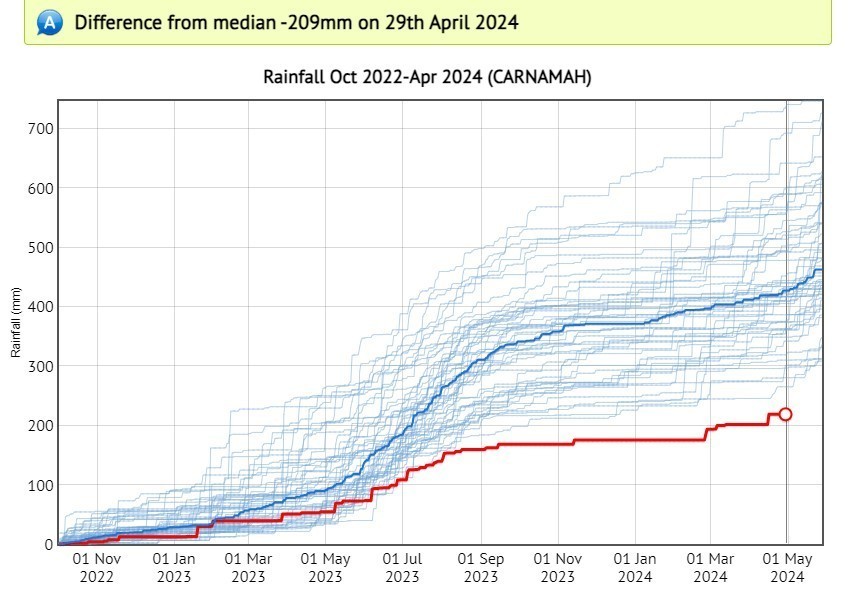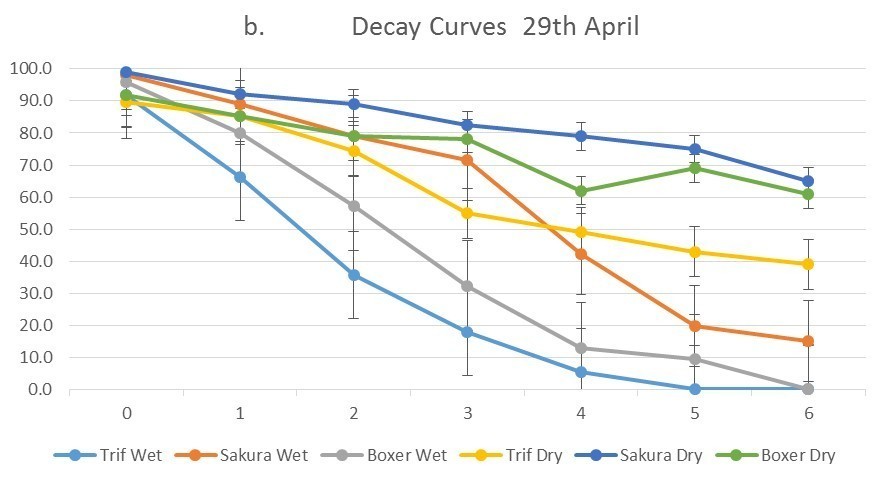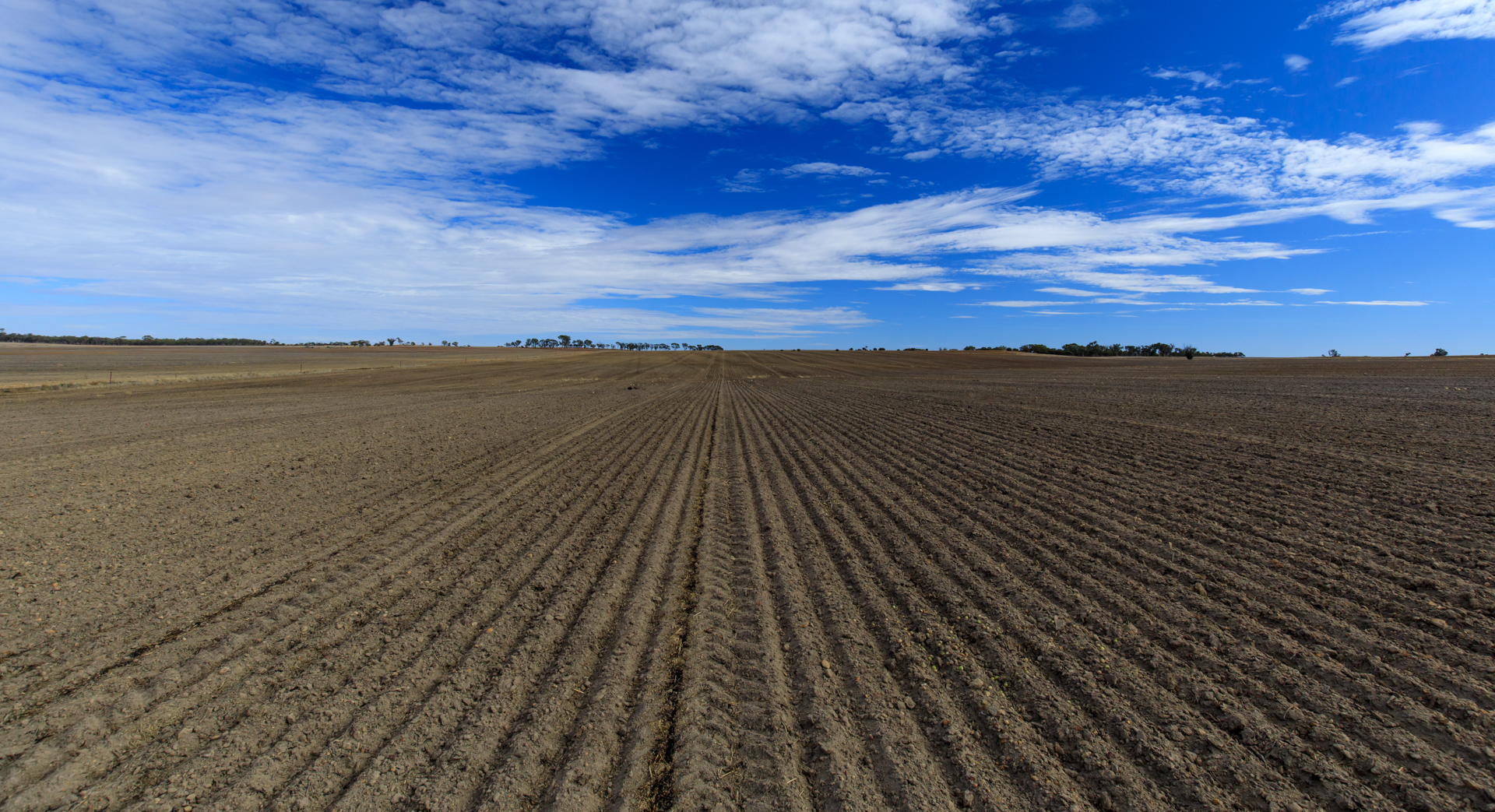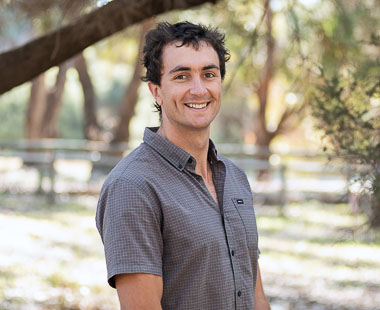2023 was a cracking drought in many parts, thanks captain obvious!

Figure 1. Total rainfall since the end of 2022 t (Red Line) at Carnamah, compared to previous 18-month periods (Blue Lines). It’s not always fun to set new records! Source: Climateapp.net.
Across much of the state there has been a focus of ensuring we mitigate the risk from chemical carryover due to the lack of rain last year and over summer. The cracking drought last year has meant that re-cropping intervals from a number of herbicdes have not been met. This is a genuine concern – there is such a thing as too much of a good thing when it comes to residual control from herbicides! How ironic to now receive multiple questions about the persistence of pre-emergent chemicals. While it may be more a symptom of stress rolling from a cracking drought into dry seeding, it is worth looking at some evidence.
A 2017 GRDC Crop updated paper by David Minkey (WANTFA) looked at the effectiveness of different pre-emergent chemicals through time after application. In 2014 and 2015 David sprayed plots with Sakura, Boxer Gold, or Trifluralin. The plots were covered with 3cm of soil within 30 minutes. Note that this is likely a better incorporation period than most growers would achieve with regards to Triflularin! That day and at 1-week intervals thereafter bioassays were taken; samples of soil into which susceptible ryegrass seeds were planted. The samples were then watered, and the control of the herbicide treated soil was measured. Pedants will note that this is a somewhat different methodology to a standard ‘incorporate by seeding’ use pattern that would be used with these chemicals, but we can still take away some findings from the paper.

Figure 2. Decay curves under wet and dry conditions for Trif (TrilfurX), Sakura and Boxer (Boxer Gold) when applied at two different dates: a. 15th April 2015 and b. 29th April 2015. Y axis is Efficacy expressed as percent of control. X axis is weeks after application of herbicide. Source: David Minkey, WANTFA.
The conclusions of this are that
- Sakura gave a longer window of control than Boxer Gold, which was greater than Trifluralin, with Sakura treatments achieving around 70% control of ryegrass after 6 weeks of sitting in dry soil.
- In this trial, for herbicides applied on 29th of April, Trifluralin gave about 40% control after 6 weeks sitting in dry soil compared to about 85% control if it rained soon after application.
From this, it seems that there can be a reduction of efficacy in Trifluralin if it sits in dry soil for weeks before the break of the season. Sakura and Boxer Gold do not seem to be affected to the same degree. This leads to 2 points. Firstly, this paper indicated that Boxer Gold and Sakura give better ryegrass control than Trifluralin, which is supported by field experience. Secondly, the accepted method of degradation for these chemicals is via microbial action, which is obviously reduced in dry soil. Microbes tend to be more active in moist soil in warm conditions, so although we have had a scorching summer and have hot soil, there isn’t likely to be much microbial action.
Consider how little nitrate and ammonium N is shown as mineralized in soil tests after a dry summer- given they are a by product of microbial activity it follows that dry soils in summer have little microbial activity. Therefore, we can assume that the pre-emergent herbicides in question should not break down very much when sitting in dry soil. This is especially obvious when comparing the other sets in the above data. The light blue, orange and grey lines show the same herbicides under wet seeding conditions. The efficacy of the chemicals reduces at a greater rate than under dry conditions, which is likely a function of moisture stimulating microbial action and breaking down the herbicides.
So, if you are dry seeding and the break of the season might be weeks away, be aware that as long as the soil is dry, chemicals like Boxer Gold and Sakura will work effectively at the end of the dry spell. But, be wary that Triflularin may have reduced efficacy if it is sitting in dry soil for too long.
For further reading, the below table shows common pre-emergent / residual herbicides, and the mode of degradation.

Figure 3. Selected herbicides and their mode of loss in the soil. Accessed from GRDC. SoilBehavPre-EmerHerbicides_2307_Web.pdf (grdc.com.au)
Microbial activity is the main pathway of degradation for most pre-emergent chemicals, which is obviously dependant on soil temperature, the organic carbon content of the soil, and having adequate soil moisture. Some exceptions, such as Atrazine/Simazine being broken down through Hydrolysis, which is a process also dependant on soil moisture! There is some evidence that microbes can metabolise triazines, but the lesson remains the same: In dry conditions, there is low risk of herbicides degrading. Obviously, there is though some loss of efficacy, and some herbicides are more effected than others.
The upshot of this is that most of our pre-emergent herbicides are broken down by microbes. Given the parched soil conditions, there will be precious little microbial activity. Based on the study presented above, Trifulralin will persist the least in a dry seeding scenario and Sakura will persist the most.
So, what does this mean? One conclusion to draw from this is that you may be getting limited value from Trifluralin if applied at the start of the seeding program. Even in wet seeding situations, its performance can be heavily reduced 6 weeks after application. With ryegrass germinating once temperatures drop there could be at least 6 weeks from a theoretical start of dry seeding (April) until we get a flush of ryegrass (June). This could align with a drop in efficacy from the Trifluralin of 40% or more. Although Trifluralin has value as a mix partner from helping to ensure ryegrass control in less-than-ideal conditions, it may have run out of puff by the time it needs to do its job! So be wary that there may be limited value from applying Trifluralin in dry conditions in April/ early May if the break of the season is statistically many weeks away!
Trifulralin still demonstrates good value for adding a mix partner to other pre-emergent chemicals, and there is little documented resistance to it in WA. Especially in the context of cheaper and ubiquitous generic Sakura (Pyroxasulfone) takings steps to limit the development of resistance is crucial. But if you are dealing with paddocks that already have low weed burden, the selection pressure is already quite low. And further, if applied in April in dry conditions there is less value from the mix partner if it is mostly run out legs by the time the ryegrass germinates!
Conclusion
- Mixing Trifluralin with Sakura remains a good strategy – they have different modes of action and physical properties which means they cover different bases. There is a reason that a tank mix of the two often results in the best ryegrass control in trials! But there is evidence that Trifluralin loses some of its efficacy if applied weeks before the opening rain. Combined with ryegrass often not emerging until temperatures drop means that Trifluralin might easily be sitting in soil for 6-8 weeks before it has a chance to be effective on ryegrass.
- If you have low ryegrass burdens, have historically been very diligent with mixing and rotating herbicide groups for ryegrass control, and would dearly love to trim the herbicide budget a bit, consider that mixing trifluralin with Sakura in very early dry seeding situations might not be the best use of $12/ha.
- Chemicals are just one part of weed control. Mixing crop types, harvest weed seed control, and crop competition are all important to reducing weeds. You don’t need to get weed control in a drum!
New resources for growers considering fertiliser options amid shortages | Groundcover (grdc.com.au)


